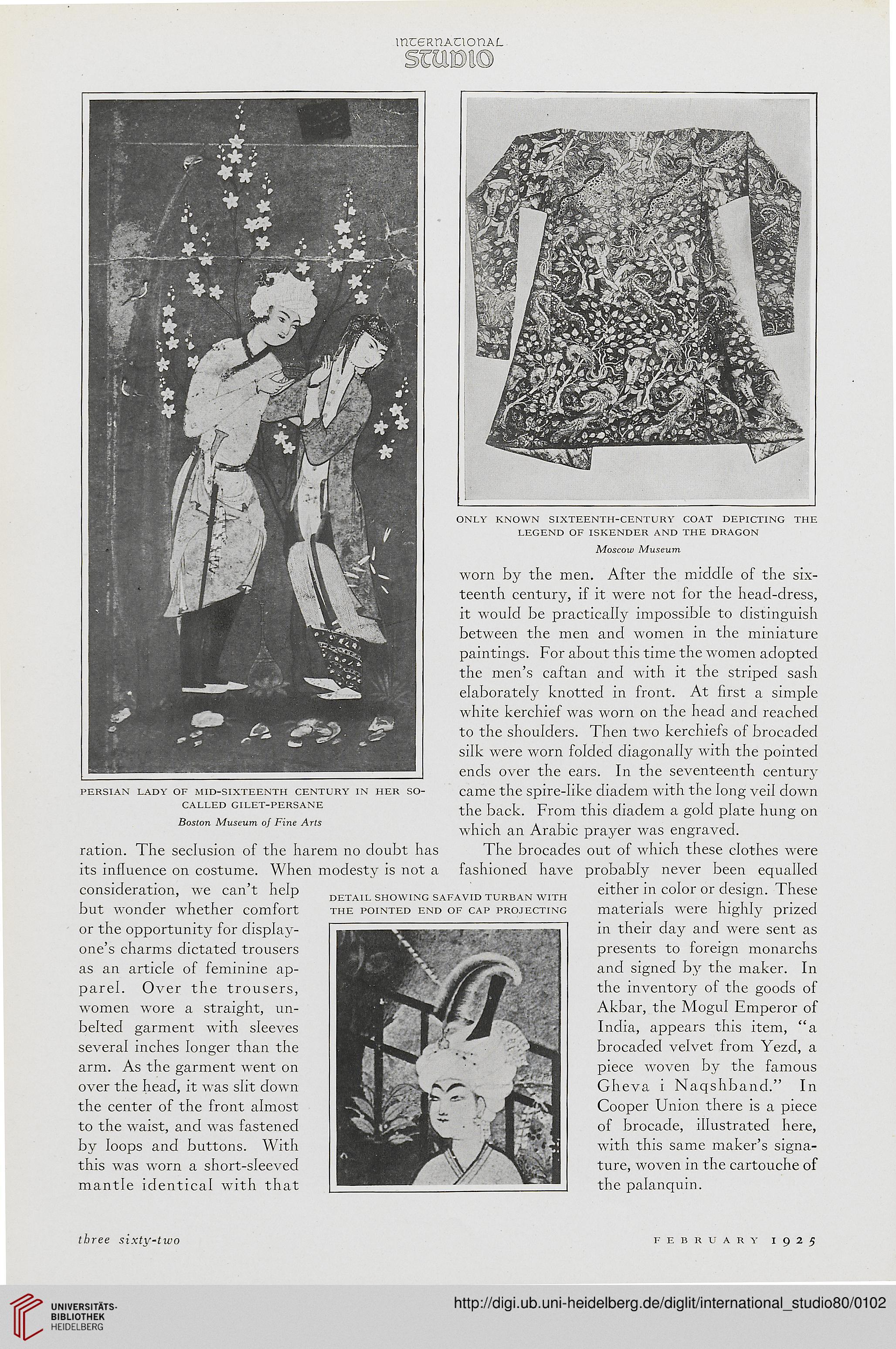mceRnAttonAL
only known sixteenth-century coat depicting the
legend of iskender and the dragon
Moscow Museum
worn by the men. After the middle of the six-
teenth century, if it were not for the head-dress,
it would be practically impossible to distinguish
between the men and women in the miniature
paintings. For about this time the women adopted
the men's caftan and with it the striped sash
elaborately knotted in front. At first a simple
white kerchief was worn on the head and reached
to the shoulders. Then two kerchiefs of brocaded
silk were worn folded diagonally with the pointed
ends over the ears. In the seventeenth century
Persian lady of mid-sixteenth century in her so- came the spire-hke diadem with the long veil down
the back. From this diadem a gold plate hung on
which an Arabic prayer was engraved,
ration. The seclusion of the harem no doubt has The brocades out of which these clothes were
its influence on costume. When modesty is not a fashioned have probably never been equalled
consideration, we can't help detail showing safavid turban with either in color or design. These
but wonder whether comfort the pointed end of cap projecting materials were highly prized
called gilet-persane
Boston Museum of Fine Arts
or the opportunity for display-
one's charms dictated trousers
as an article of feminine ap-
parel. Over the trousers,
women wore a straight, un-
belted garment with sleeves
several inches longer than the
arm. As the garment went on
over the head, it was slit down
the center of the front almost
to the waist, and was fastened
by loops and buttons. With
this was worn a short-sleeved
mantle identical with that
in their day and were sent as
presents to foreign monarchs
and signed by the maker. In
the inventory of the goods of
Akbar, the Mogul Emperor of
India, appears this item, "a
brocaded velvet from Yezd, a
piece woven by the famous
Gheva i Naqshband." In
Cooper Union there is a piece
of brocade, illustrated here,
with this same maker's signa-
ture, woven in the cartouche of
the palanquin.
three sixty-two
FEBRUARY I 9 2 5
only known sixteenth-century coat depicting the
legend of iskender and the dragon
Moscow Museum
worn by the men. After the middle of the six-
teenth century, if it were not for the head-dress,
it would be practically impossible to distinguish
between the men and women in the miniature
paintings. For about this time the women adopted
the men's caftan and with it the striped sash
elaborately knotted in front. At first a simple
white kerchief was worn on the head and reached
to the shoulders. Then two kerchiefs of brocaded
silk were worn folded diagonally with the pointed
ends over the ears. In the seventeenth century
Persian lady of mid-sixteenth century in her so- came the spire-hke diadem with the long veil down
the back. From this diadem a gold plate hung on
which an Arabic prayer was engraved,
ration. The seclusion of the harem no doubt has The brocades out of which these clothes were
its influence on costume. When modesty is not a fashioned have probably never been equalled
consideration, we can't help detail showing safavid turban with either in color or design. These
but wonder whether comfort the pointed end of cap projecting materials were highly prized
called gilet-persane
Boston Museum of Fine Arts
or the opportunity for display-
one's charms dictated trousers
as an article of feminine ap-
parel. Over the trousers,
women wore a straight, un-
belted garment with sleeves
several inches longer than the
arm. As the garment went on
over the head, it was slit down
the center of the front almost
to the waist, and was fastened
by loops and buttons. With
this was worn a short-sleeved
mantle identical with that
in their day and were sent as
presents to foreign monarchs
and signed by the maker. In
the inventory of the goods of
Akbar, the Mogul Emperor of
India, appears this item, "a
brocaded velvet from Yezd, a
piece woven by the famous
Gheva i Naqshband." In
Cooper Union there is a piece
of brocade, illustrated here,
with this same maker's signa-
ture, woven in the cartouche of
the palanquin.
three sixty-two
FEBRUARY I 9 2 5




